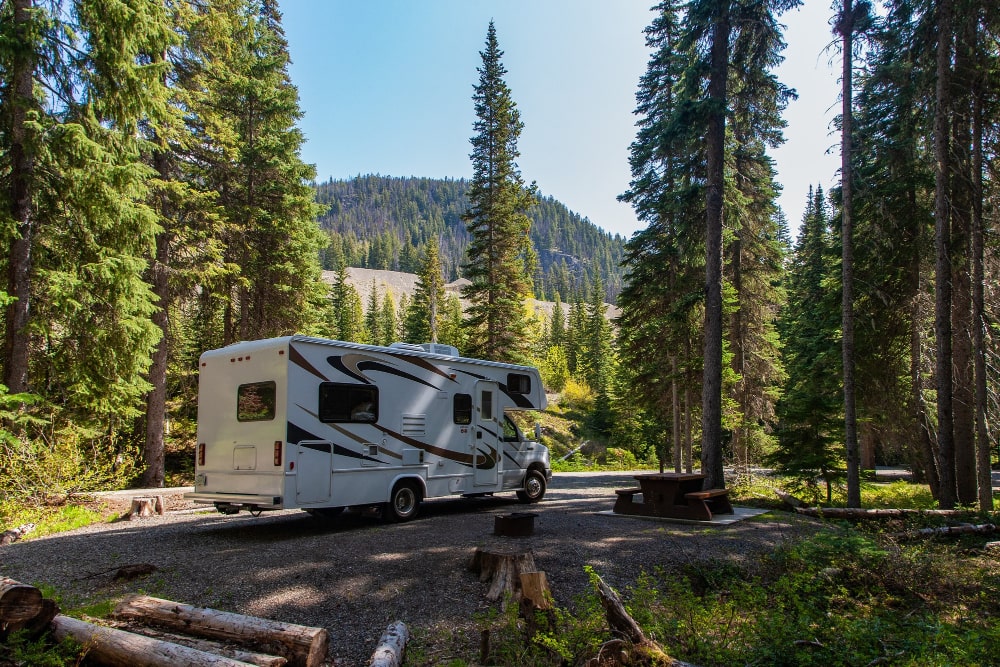I recently inquired with RV salesmen about buyer preferences. They unanimously mentioned a pattern: those opting for a Class C often end up trading it for a Class A. Conversely, once someone invests in a Class A, the likelihood of switching is notably rare
Why Opt for a Class A RV?
When it comes to motorhomes, the Class A stands out. Sales trends and preferences among full-time RVers indicate a marked inclination towards Class A Motorhomes. While the Class C has its appeal, the majority favor the Class A for various reasons.
Investing in a Class A RV demands thorough research and consideration. A prudent step is experiencing one before committing to a purchase.
Automatic Leveling Systems
Typically, Class C motorhomes lack automatic leveling due to their lower ground clearance. Automatic jacks occupy substantial space below, restricting clearance. While a few, like certain Jayco models, offer this feature, it’s uncommon.
Conversely, most contemporary Class A motorhomes are equipped with automatic leveling systems. This factor holds great significance for me, given that managing leveling and stabilizers has been among the most challenging aspects of owning my travel trailer.
Ample Seating Space in the Driver’s Area
While a Class C has a width akin to a truck, its living area box is considerably wider. Consequently, the driver’s area feels narrower compared to a Class A. In my experience, the confined space in a Class C, particularly with the presence of the dog house, feels a bit cramped for driving comfort.
Abundant Underbelly Storage in Class A RVs
Class A RVs outshine Class C in terms of storage capacity due to their elevated build, offering extensive storage options. While some Class Cs boast ample storage, as a frequent road-tripper rather than a full-time dweller, I find the existing storage in my Class A RV more than sufficient—though extra space is always welcome!
Year-Round Weather Protection
While some Class Cs excel in winter preparation, it’s more uncommon. Many have exposed dump valves and pipes beneath the coach, vulnerable to freezing. Contrarily, Class A RVs often house these components within insulated compartments, enhancing protection against freezing temperatures.
RV Length Variance
Typically, Class C motorhomes span 27-32 feet, with the Jayco Seneca being an outlier at 39’1″. In contrast, Class A RVs often range between 35-40 feet, with some models like the Gulf Stream Constellation reaching 45 feet, albeit challenging for national park campsites due to size.
Aerodynamic Challenges
Class A RVs, being taller, can encounter wind-related issues and rollover risks. In contrast, the Class C’s large cup-shaped cab-over significantly impacts forward-facing aerodynamics, leading to increased wind noise and road travel difficulties.
Roof Material Quality
Class C motorhomes often feature rubber ceilings that may pose durability issues over time. Conversely, Class A motorhomes commonly utilize fiberglass roofs, generally known for their better overall durability. While exceptions exist, Class A roofs tend to offer superior quality.
Robust Chassis Design
The Class A chassis is akin to a solid foundation with a steering column and engine, providing a robust frame. In contrast, a Class C starts as a truck without a rear bed, offering a less substantial chassis akin to a regular truck.
Class A RVs: A Smarter Investment Choice
Researching RV depreciation revealed an intriguing insight: Class C motorhomes tend to depreciate faster compared to Class A models. While exceptions exist, Class C’s swift sales are attributed to their affordability, appealing to many travel trailer buyers.
Driver’s View
The restricted visibility in a Class C, particularly in the driver’s seat, is one of its drawbacks. The cab-over design obstructs the top view, limited rear visibility due to the wider living area, and a lower driving position.
Opting for a Class A RV provides a contrasting experience; it feels more akin to piloting the Millennium Falcon, with expansive windows offering panoramic views.
Efficient Living Space
Class A RVs maximize their space utilization by allowing the driver and passenger chairs to convert into part of the living area, expanding the available room and offering extra seating. This contrasts with Class C RVs, where the limited design often renders the driver and passenger chairs as unusable space when parked, making the Class A an appealing choice for me.
Enhanced Passenger View
The expansive front windshield of a Class A RV provides an enjoyable ride for passengers, allowing them clear views of the surroundings. Compared to a Class C, where passengers may have limited visibility through the front window.
Washer and Dryer Availability
While rare in Class C motorhomes, washers and dryers are more commonly found in Class A models. If laundry amenities are a priority, a Class A RV might better suit your needs.
Transitioning Between Driving and Living Spaces
In a Class A, transitioning between driving and living areas is effortless—spin your chair or walk through. In contrast, a Class C requires a cumbersome maneuver, often involving hunching and navigating around the dog house to access the living area.
Cab-Over Water Intrusion
Class Cs often suffer from cab-over leaks, a prevalent issue. Opting for a Class A eliminates this concern entirely.
Comfortable Ride
In comparison, the ride in a Class A motorhome offers superior comfort over a Class C. While a Class C feels similar to driving a U-Haul, a Class A provides a ride akin to a city bus, offering a smoother experience.
Air Quality Control
In the realm of heating and cooling, Class A motorhomes often boast two air conditioning units, whereas the majority of Class C motorhomes come with just one. Despite the larger size of Class A models, the ratio of air conditioning to interior space tends to be more substantial than in a typical Class C motorhome.

